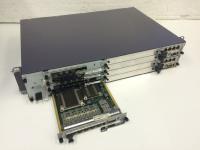Shielding Measurement of Electrically Large Enclosures with Contents
This collaborative project with Huawei Technologies is developing and and implementing production enclosure shielding effectiveness qualification methodologies for certification of information and communication technology (ICT) enclosures at frequencies from 1 to 30 GHz for use in Huawei’s Global Compliance and Testing Center.
Overview
Current enclosure shielding effectiveness measurement standards, such as IEEE 299.1 assume that the equipment enclosure is empty during the assessment. Modern ICT equipment enclosures are densely packed with printed circuit boards (PCBs), power supplies, fans and other components. The internal electromagnetic field distribution in a populated enclosure is dramatically different from that in the same enclosure when it is empty due to the more complex topology and absorption of electromagnetic energy in the internal components. Since both the reliability of the equipment in the presence of external electromagnetic interference and the electromagnetic emissions of the equipment itself are dependent on the internal loading of the enclosure it is therefore necessary to develop a qualification methodology with controlled representative contents that can account for these effects.
Power balance techniques were employed to develop representative contents for both a reverberation chamber measurement methodology and a full-wave simulation methodology that are able to determine the average shielding effectiveness of an enclosure when populated with contents drawn from a class of PCBs. The average absorption cross-section (ACS) was found to be the best simple metric to use for matching the characteristics of the representative contents to real PCBs. A large number of PCBs were measured to determine a statistical basis for the design of the representative contents (missing reference), supported by theoretical development of the uncertainty analysis of the ACS measurement technique (Flintoft et al., 2016). It was also demonstrated how the shadowing effects of closely spaced PCBs could be measured and accounted for in the power balance models (Parker et al., 2016; Parker et al., 2016).
The new measurement based qualification methodology is based on IEEE 299.1, but with additional procedures for configuring the representative contents and more stringent requirements on the fields probes and their use. In particular, probe proximity effects are more significant in the densely populated loaded enclosures and further calibration procedures are necessary to obtain reliable results. The methodology was initially validated on simple enclosures (Marvin et al., 2016; Parker et al., 2016) before been applied to real ICT equipment.
The first phase of the project was completed in September 2016 after successful cross-site testing of the new methodologies using prototype representative content devices in the University of York's facilities and Huawei’s Global Compliance and Testing Center.
As part of this work we have also developed diffusion based techniques to determine the variation in fields in lossy reverberant enclosures (Flintoft et al., 2016; Yan et al, 2019). A link to some examples using the FreeFEM++ finite element solver can be found on our resources page.

Members
- Andy Marvin
- Ian Flintoft
- Simon Bale
- John Dawson
- Martin Robinson
- Sarah Parker
- Jiexiong Yan
Sponsors
- Huawei Technologies
- York EMC Services (Eurofins York)
Links
- York Research Database (Publications, Related Projects, etc.)
- PhD Thesis: Shielding Effectiveness of Reverberant Enclosures Containing Printed Circuit Boards, Sarah Parker, 2018
- PhD Thesis: Investigation on shielding effectiveness of reverberant enclosures with contents, Jiexiong Yan, 2019
Research
